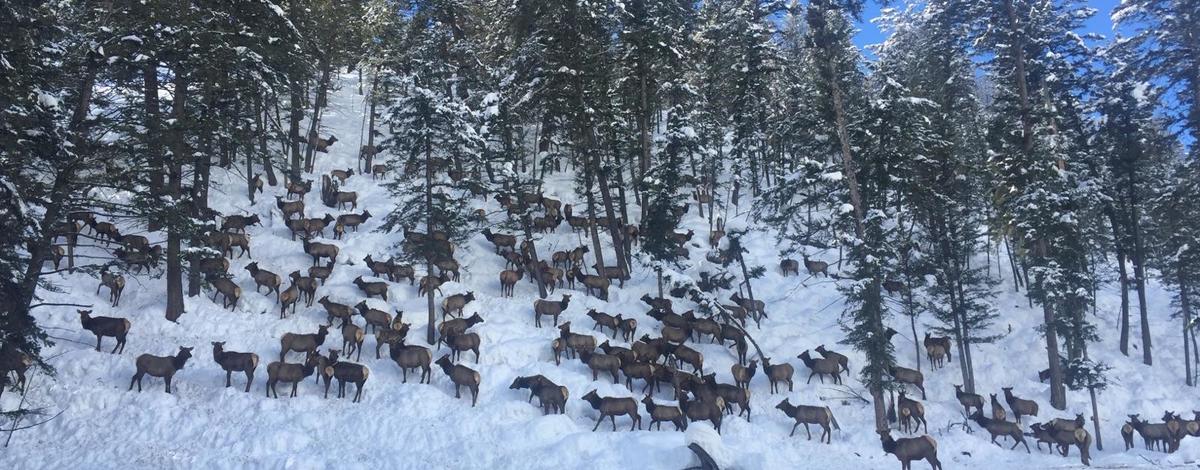History
Fish and Game's Upper Snake Region has significant history of winter feeding and has an active Winter Feeding Advisory Committee. The Henry Creek Fire burned over 50,000 acres in the summer of 2016, including over 30,000 acres of the Tex Creek Wildlife Management Area. Tex Creek WMA provides significant winter range for about 4,000 elk and 4,000 mule deer. The winter range on Tex Creek is critical for the maintenance of those herds and the hunting opportunity they provide across eastern Idaho and serves to keep the majority of those herds from depredating on nearby private agricultural ground.
Shortly after the Henry Creek Fire, Fish and Game began preparing plans to mitigate the loss of critical winter range including: habitat restoration, expanded harvest opportunity, planting of lure crops and a large winter feeding program. Fish and Game staff consulted with the Upper Snake Winter Feeding Advisory Committee, private land owners surrounding the Tex Creek WMA and the hunting public when planning actions to respond to the loss of critical winter range.
The loss of natural forage from the fire is not expected to cause significant nutritional based mortality to the elk herd, but will primarily impact elk behavior resulting in significant numbers of elk moving onto surrounding agriculture fields. Winter feeding of elk is primarily designed to keep elk on the feeding operations and reduce elk depredations on surrounding agricultural fields.
Winter feeding of mule deer is intended to provide a nutritional substitute for lost natural forage and prevent significant losses to the herd. A short term reduction in the wintering mule deer within the fire scar might be a benefit to habitat recovery, and the overall health of this segment of the mule deer population. Staff expects some level of mortality to the wintering deer population within the area impacted by the fire.
Upper Snake regional staff bought and positioned 2,000 tons of dairy-quality hay in September in preparation for feeding operations in the winter of 2016-17. Feeding commenced on December 4 and has continued uninterrupted. Three Fish and Game employees spend 100-percent of their time on the feeding operation.
January 30, 2017 status report
Daily feeding of approximately 3,500 to 4,000 elk at Tex Creek WMA. Deer remain scattered and not on the feeding area.
Tex Creek is currently the only emergency feeding operation in the region, but managers are monitoring snow conditions and animal behavior to evaluate need to add more. Warmer temperatures in mid January improved conditions for wintering big game by opening up some south-facing slopes.
F&G currently has at least 40 depredation issues on private lands where F&G managers are working with landowners. They have responded to 90 big game depredation issues this winter. To help alleviate depredation issues in many areas of the regions, kill permits have been issued to landowners experiencing significant problems. In addition to kill permits, two elk depredation hunts were created in Unit 50 and Unit 51.
Big game depredations and winter feeding update
Winter conditions have resulted in an increase in haystack depredations throughout the region since mid January. Depredations are heavy throughout the region. Landowners are encouraged to move haystacks out of high depredation areas if possible.
Due to the recent fire on the Tex Creek Wildlife Management Area, F&G implemented feeding operations on Dec. 8 on the wildlife management area and is feeding about 3,500 to 4,000 big game animals. All roads into the Tex Creek WMA have been closed due to feeding operations and prevent added stress on wintering animals.
Snow depth and condition of animals are being closely monitored. Regional staff is in close contact with the regional winter feeding advisory committee in the event that more winter feeding is warranted.
Here are current snow depths
Sand Creek, Hamer: Snow depth is 12-14 inches with light to moderate crusting. Animals are moving freely on winter ranges.
Swan Valley: Snow depth is 18-20 inches on the valley floor with light to moderate crusting. South facing slopes are at 20-22 inches. Animals are moving freely on winter ranges.
Teton Basin: Valley floor has 20-22 inches of snow with light to moderate crusting. South facing slopes are at 14-16 inches. Animals are moving freely on winter ranges.
Big Desert, INL: Snow depth is 13-15 inches on valley floor with light to moderate crusting observed. Animals are moving freely on winter ranges.
Birch Creek: Snow depth is 17-19 inches on the valley floor. South facing slopes are at 6-8 inches with light to moderate crusting. Some slopes have blown free of snow. Animals are moving freely on winter ranges.
Big Lost River: Snow depth is 12-20 inches on the valley floor with light to moderate crusting. South facing slopes are at 12-14 inches with some slopes blown free of snow. Animals are moving freely on winter ranges.
Little Lost River: Snow depth is 12-14 inches on the valley floor with light to moderate crusting. South facing slopes are at 8-10 inches with some slopes blown free of snow. Animals are moving freely on winter ranges.
Tex Creek: Snow depth is 18-20 inches with 6-8 inches on the south facing slopes with some of those slopes blown free of snow. Light to moderate crusting observed. Animals are moving freely on winter ranges.

